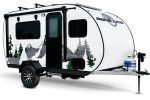Basics of Off-Grid RVs
for Full-time Living
Basic requirements for off-grid RVs designed for comfortable full-time living: what you have to know before committing to buy one.
At the roots of the camping experience was always the wish to re-establish the strong “relationship” with the Mother Nature that we gradually lost since the dawn of the urbanization process. At first, this everlasting dream of re-integration with nature was pursued by backpacking and trekking adventures. With time, RV-ing took over, becoming the preferred way to escape from our “cubicles”, surrounded by concrete walls and rivers of asphalt, from daily rituals, from our addictions including workaholism. As the result of this trend, most campgrounds slowly but surely lost their “virginity” becoming busy, crowded and noisy places too much resembling our urban environment. Not surprisingly, many of us turned to wilderness adventurers in an attempt to effectively hide from the everyday hectic life.
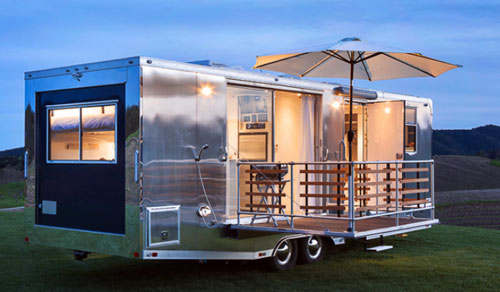
But you will rather prefer to explore the Mother Nature in this off-grid RV designed for full-time living
Living Vehicle (Live-Series)
While trekking never lost its attractiveness, these days not many of us are willing to leave the comfort of “home-away-from-home” and go back to times of backpacks and tents. This phenomenon in turn started changing the RV industry. “Off-road” RVs later followed by “explosion” of Rooftop Tents opened for exploration many “less-traveled” roads. Then, the next challenging step was almost obvious and came with the introduction of sub-class of off-road vehicles called “Off-grid” RVs.
Off-grid RVs belong to one of two subcategories determined by the length of stay in an out-of-civilization environment:
- Short-term off-grid Adventures
There is no clear definition what means short term, we can assume however, that it will be no more than one week in “out-of-grid” environment. Such adventures are popular among those loving to temporarily “jump” out of their busy lives into wilderness. Most of existing Off-road RVs meet short-term requirements, that are mainly determined by autonomy of energy, fresh water and supplies (actually, fresh water may be the determining factor). The comfort of living however, while always desirable, usually is not at the top of the priority list. In fact, most of traditional off-road RV-ers are more than happy with sort of “Spartan” living conditions. They are mostly “hard-to-die”, adventure oriented, brave, young “spirits” ready to temporarily give up on “residential” environment in exchange for life experience in the wild.
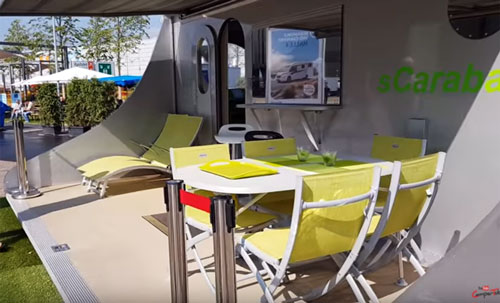
Front deck of sCarabane travel trailer shows that it is possible to live off-grid enjoying closeness of the nature but still benefit the "residential" environment...
- Long-term (Off-grid living)
This seems to be a new and rising category of Off-road RVs triggered by the growing number of “Digital Nomads”. Yes, they are bored with city-life, they long for mind-soothing scenery across the window, romantic sunsets, starry nights…. They want to “brake-free”, to explore but also create new “paths” in their lives, instead of following those already “established” by previous generations. Yet, they still have to (or want to) work and keep some living comfort they already got use to (nothing wrong with that). They usually represent a class of people with high level of environmental consciousness, understanding that sustainability of Life requires many compromises with the goal to leave behind the smallest possible “footprint”.
The bottom line is that such trends created the need for something that traditional Off-road RVs cannot offer. And this is:
Sort of “Home-away” but not from another home, but away from the traditional life-style. The Mobile Home that cuts traditional roots to a specific address, home with all (or at least most) of attributes of an eco-friendly but comfortable and modern long-term residence with a virtual address and often changing, GPS-determined locations.
Interestingly, this new way of RV-ing is popularly known as “Boondocking”. Although the word cannot be directly translated, it probably comes from clever combination of Philippine-Spanish word “bundók” (meaning "mountain"), and as a sign of time – from the computer world “docking (station)”. It seems to be referring to living in remote (mountain) areas while being still “connected” to the civilization by Internet and (when needed) with supply centers (water, food, necessities etc…) as well as dumping stations (waste and trash).
Understandably, long-term off-grid RVs must be adequately designed and furnished to meet requirements of mobile home but also office, workshop…. Let’s see then what are basic requirements for the off-grid mobile home allowing for boondocking life-style.
If you already know what you want, then go to:
Basics requirements for Off-Grid RVs
1. Energy autonomy
On a daily basis, the Long-term off-grid RV-ing requires much more energy than you may need on short off-grid trips. It is because many daily needs and rituals cannot be postponed till you are back home. The off-grid RV is your home!
Obviously, a big challenge comes from dishwasher (if any), washing and eventually drying machines (although the latter can be easily replaced by the Mother Nature), fridge (can also run on LPG with very little use of electrical energy) and microwave oven. These are power hungry machines that will quickly drain your batteries if you cannot feed them fast enough from external energy sources.
And we are not even mentioning an A/C unit despite the fact that in hot and humid days, relying only on opened windows and power fans may be a too optimistic approach.
Add to that a bunch of kitchen appliances (coffee-maker, blender, grinder toaster, electric kettle etc…), hair dryer, TV, lights and in general all kinds of electronics as well as supporting components like water-pump, power fans, furnace’s air blowers and the picture is clear – we are very much energy-hungry. Connected to the shore power, we do not even think about it nor pay much attention to it (well, maybe once a month when we get the bill). That’s why for many of us, starting to live in an off-grid environment is a totally new world, something we have to get used to.
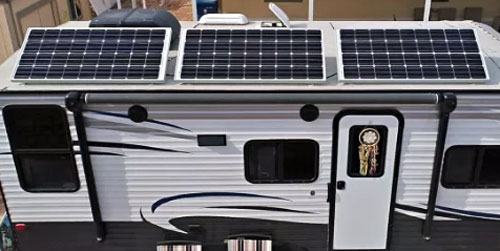
Tilted solar panels installed on the RV roof
Courtesy of: www.fateunbound.com
Solar Power
Solar panels are a preferred source of renewable electrical energy for an RV. For practical reasons, most solar panels are roof-mounted by the factory. This minimizes the risk of theft and damage, but also makes their operation almost “hassle-free”. However, this method has also serious shortcomings.
- there is only limited free space on the roof, what automatically limits the amount of total installed power.
- for higher efficiency, it forces RV-ers to keep their “home” exposed to sun. This in turn will cause problems with keeping comfortable interior temperature during summer (cooling systems are just too power-hungry to keep them running over longer periods of time).
- for better efficiency, solar panels should be tilted towards the sun. Automatic sun-tracking systems are simply pricy, while manual tilting nullifies the hassle-free operation. You have to also remember to set them flat before leaving the camping, otherwise they will fly-out when on the road.
These conflicting requirements are certainly easier to meet with exterior solar panels that can be deployed in a sunny area, while the rig is kept in a shade. Also, they usually come with the supporting structure allowing for tilting.
The major drawback – it may be risky to leave them outside for “grab”, when you would like to go away for a day. And constant hiding and re-deploying process will take too much of joy we are looking for when boondocking.
The bottom line: when looking for an off-grid RV, make sure that it has large unobstructed area on the roof for solar panels (the best when it already come with installed panels) and that it has also an installation to hook-up popular external solar systems (if needed).
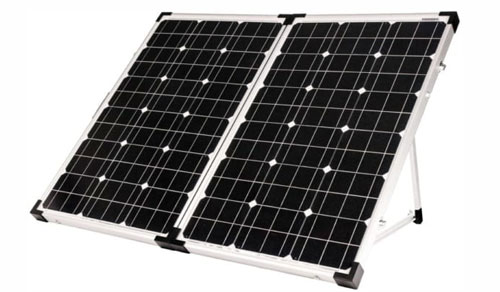
Go-Power 120W mobile kit of solar power
Wind-power
When limited to a reasonable size, wind blades and turbine cannot provide enough of energy for full-time living. But at least (weather permitting) they can continuously feed batteries on the 24/7 basis. Backed by solar power, together these two sources of energy can make the off-grid living energetically sustainable.
But there is the price to pay for – the constant, low frequency noise that at the best can be just annoying, for some however heavily disturbing (unless you get used to it).
While currently, the RV industry left behind the “wind-technology” as a source of renewable energy, some attempts to change this practice can be already seen.
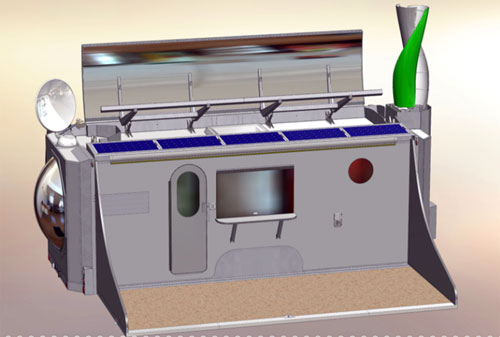
sCarabane (Computer model) - visible are all three sources of energy: Solar Panels (dark blue), Vertical Wind Turbine (green) and the largest component: Parabolic mirror (Heat concentrator).
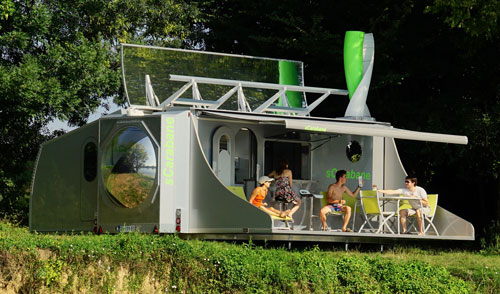
sCarabana - real unit with visible on the roof Heat Concentrator and wind turbine
LPG
Liquide Propane bottles (regardless how big they are) one day will run “out of gas”, but it will be hard to meet all energy needs without them. However, because anyhow from time to time you have to go to a nearby grocery shop (even if the “nearby” is still far away), LPG is (and it will be in the future) an essential source of energy in any off-grid RV. It’s also the one that can deliver required “peak-power (heat)” over an extended period of time. Due to shortage of renewable electrical energy, the propane is almost exclusively used for heating (water and when needed - interior), cooking and sometimes also for refrigerating.
Diesel Generator
It’s bulky and noisy, but it’s nice to have it for cloudy days and times of extra power demand. However, it is only solution for short-term off-grid adventures, because the energy autonomy is limited by the size of the diesel tank. Yet, it may be an easiest to implement and so preferred solution for few days’ trips to wilderness. On the negative side – regardless of how strongly manufacturer claims that it works “quietly”, you will find it noisy - especially being in the middle of nowhere, where rightfully you expect to listen to “Voices of Nature”. Good thing – most likely no one else will get annoyed, just you (but still, it can be more than you can take ).
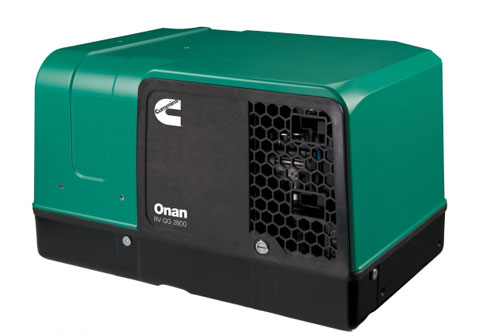
Cummins' Onan Generator QG 2800 (2.8kW) designed for RV
Batteries
Solar power has clearly periodic nature determined by daylight’s limits (these in turn depending on your geographical location and season of the year). Both sources (sun and wind) have also randomly-occurring limitations like cloudy sky (significantly limiting the received solar energy) and no wind. To overcome these problems, the sizable bank of storage batteries is necessary to guarantee the availability of energy on a 24-hours basis. In practice it means: an off-grid RV must have a large-enough, dedicated exterior compartment for storing deep-cycle lithium-based batteries (note that traditional lead-acid batteries are too heavy and bulky for the capacity they offer, the lithium ones have their own problem - it's their price $$$).
The question – how much of installed solar/wind power (kW) and how big battery’s capacity (Ah), depends on individual needs, but certainly it will be more than 1kW. Same with LPG tanks, Generator and fuel tank.
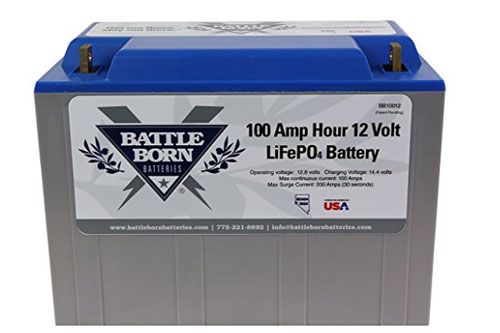
Lithium-ion deep-cycle battery by Battle Born: 3k-5k cycles, 100A continuous and 200A surge current
Energy-efficient appliances
Make sure that your off-grid RV is equipped with appliances representing the latest technological achievements in energy efficiency. LED-lights with dimmers, energy-stars rated equipment etc… are the "must" to make your mobile-living dream coming true
Tune your habits (even small phone charger when plugged and idling, consumes some energy and such "waste" adds up quickly...)
For RV cooling options see: --> RV A/C Units
For RV heating option see: --> RV Heating Systems
Summarizing: While these days it may be still costly, the future of renewable energy is very promising so, the energy autonomy will not be a limiting factor of full-time living in off-grid environment....
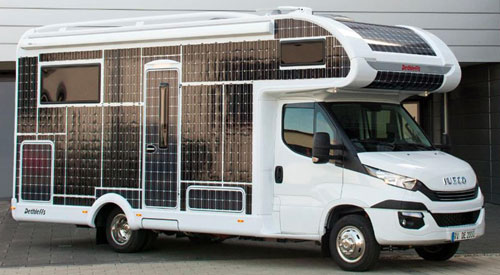
German Dethleffs is an electric motorhome. It may not look very elegant, but these head-to-toe solar panels seem to guarantee that you never have to worry about finding the next charging station. And when it comes to boondocking - you will neither run out of energy in off-grid environment :-)
Source: Dethleffs
2. Fresh water autonomy
It’s impossible to live without continuous access to fresh water, but unfortunately not much can be done on this subject in an off-grid RV. The most viable solution is to equip the rig with large water tanks, water-efficient appliances and change “wasteful” habits (like for example taking long showers…
Taking short ride in your towing vehicle to nearby shop or gas station to buy provisions is part of the life, however pulling your large rig over no-man’s land and dirt roads (if any), to re-fill water tanks is another story!
So, when an off-grid RV is intended for full-time living it may be crucial to take few helpful steps:
- Some RVs are equipped with water filters, however most of them are designed only to remove heavy minerals (for example calcium) from supplied city or fresh water.
To purify and make drinkable water from the nearby lake or water stream you camp next to, better and more efficient filters are needed (make sure they are certified for such job). So, while such filter may not be part of standard RV features, consider installing it before “taking off”. It will substantially increase RV’s water autonomy.
- It will greatly help if the rig is equipped with independent drinking water and technical water systems. The latter could be used in bath (toilet and shower), laundry machine and for general use (cleaning, washing etc…), but also for drinking provided it is boiled.
Unfortunately, it does not seem that now such solutions are available on the market. You can easily however make your own “drinking water system” by buying widely available large plastic containers with spring water.
- Make sure that your water-distributing system is equipped with water-saving devices like low-flow shower head with shut-off valve, low-flow faucets with aerator. These modifications together with installation of composting toilet can largely extend your water autonomy (more about the latter below).
- Capturing the rain water is another possibility, however if you want to go for that, make sure your RV is equipped with gutters! Note, tat due to the unpredictability of weather, rain cannot be considered as a reliable source of drinking water, but rather as a “bonus”.
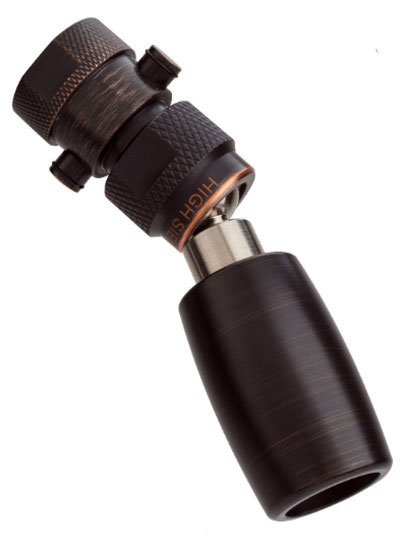
High Sierra 1.8 GPM Low-flow shower head w/valve
Summarizing - periodic trips to a drinking water tap is a must and when doing so you may also drain waste water tanks …
3. Waste water
While in practice the “management” of waste water tanks can take different forms, the eco-oriented RV-ers certainly will not drain their tanks at the first “opportunity” under the cover of night. It’s illegal! So, there is only one way to deal with waste water tanks – make the trip to the closet dump station. And the only think you can do is:
- Chose the RV model with large-capacity waste water tanks (Grey and Black)
- Carefully manage the use of water
However, there are already some solutions that can “soften” the gravity of problems.
Grey Water Tank
- In most states it is legal to release the content of the grey-water tank into nature, if and Only IF you exclusively use bio-degradable/all-natural washing and cleaning products (To be on the safe-side, check with local authorities). To be also on the eco-friendly side – “disperse” (sprinkle) it in a suitable area to not cause any problems to nature lovers and eventual neighbors. Note – never just dump it in one place!
- If the Grey-water tank is equipped with filtration system removing potential solid waste, the grey water can be re-cycled (in this case used for the toilet). To make it happen however, manufacturers will have to come up with such option (smaller grey-water tank, larger black water tank and the separated plumbing for toilet).
Black Water Tank
In all US states and Canada, the content of the black-water tanks is allowed only into designed for this purpose dump stations! So, there is not much you can do to eliminate periodic trips with your rig to designated dumps.
However:
- You can fully eliminate the need for black-water tank by switching to a ”Composting Toilet”.
This is so-called “dry-toilet” that does not use water nor chemicals and does not need plumbing. Shortly speaking – it is a kind “mini eco-system” where “liquids” and “solids” are separated to undergo “bio-degradation” process. The end result is an organic waste (sort of “compost”) that can be legally dumped in the nature (it is suggested to dig a hole, dump and then cover with soil).
For many, it may sound a bit strange, but apparently, such toilets are not only user-friendly, but in practice, also not much different than traditional water-flushed ones.
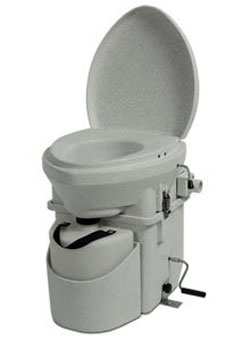
Nature's Head Dry Composting Toilet with Standard Crank Handle
4. Trash
Generation of trash is an inevitable process deeply rooted in our life. While in our residence we have few large garbage bins to collect “urban” waste, plastic, glass, metal etc, the off-grid RV does not offer such luxury. Limited interior space and danger of keeping it outside due to exposure to “wildlife” (not only wild predators but also all sorts of crawling creatures and insects) forces us to strict rules:
- Opt for an RV with trash chute and bin in the “underbelly” with exterior access. It will help to keep living quarters clean and odor-free.
- Whenever possible, eliminate from your life plastic, glass and metal (bags, bottles, cans, containers, etc) that you do not have intention to re-use. Instead, opt for unprocessed food that does not need any special packages (in other words eat fresh foods).
- It may not be possible to separate and compact plastic, glass, metal and paper trash (limited space for garbage bins) but try to separate “organic trash”. It can be composted and disposed into nature (with respect to the latter and laws). By doing so, you will also minimize the unpleasant smell and prevent invasion of insects.
But the ultimate solution is your trip to the “Civilization” (parking lot, shops etc) and dispose the trash in dumpsters.
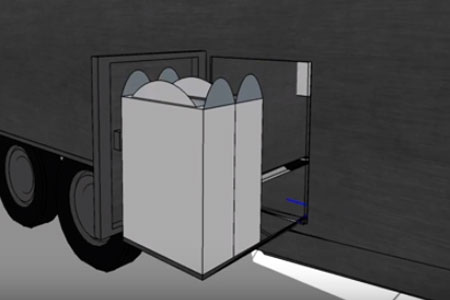
Idea of the Trash Chute (this one was implemented in the off-grid Living Vehicle)
Summarizing the off-grid autonomy of RVs:
It may all sound discouraging, but hey, even if you go for a year-long boondocking adventure, you are not fully cutting contacts with civilization (unless you also want to go millennia-back in time and become a gatherer-hunter). So most likely, every once in a while, you will have to make a trip in your towing vehicle to re-supply your off-grid mobile home. Taking trash with you and bringing food, toiletries, propane, fuel and in general small stuff, should not cause problems. The real headache will be rather re-supplying water and dumping waste-tanks, because for that to happen, you will have to take for the trip the whole mobile home!
5. Design
Full-time living in an off-grid RV is not only the matter of acceptable energy and water autonomy. You may have all that, but still be frustrated and annoyed by never addressed “practical issues” impacting the comfort of “mobile-life” instead of enjoying benefits of your new life-style. The bottom line is that RVs designed for full-time off-grid living must be specially designed with this goal in mind to guarantee (on top of discussed earlier energy and water autonomy) the following:
- Lightweight
The idea of “Lightweight design” is already widely embraced by the RV world. However, in the case of off-grid rigs that almost “by definition” should be designed as “off-road” units, it’s not only about better fuel efficiency and towing requirements. Note that all off-road RVs undergo much higher dynamic stresses than those driven on flat highways. And higher the weight, higher dynamic stress on shell, chassis, suspension and axles. To guarantee RV’s reliability, these vital elements must be overrated (over-designed) what obviously increases the cost and unfortunately – also the overall weight. That’s why, most of all-terrain RVs are either small (not suitable for full-time living) or when larger - built based on military-grade trucks when weight and cost does not really matter that much (so not affordable).
Bottom line: Lower weight and good “over-rating” coefficients for essential mechanical components, better the overall reliability in “no-roads” environment.
- All-season design
Long term off-grid RV should be designed for four-season living. While this requirement may be difficult to meet in northern states (not even mentioning Alaska) where the temperatures can drop to low digits, it is achievable across the large parts of US central and southern states. The main limitation is obviously determined by the quality of thermal insulation and energy needs required for heating. For details see: --> RVs' Thermal Insulation
Note that to mitigate the effects of climate, full-time off-grid RV-ers should follow the rules since forever known to nomadic tribes and nature. And the fundamental one embedded in genes is seasonal North-South migration in a search for more comfortable living conditions. Finally, if you decided to live in the Mobile Home, you do not want to develop roots in one place, but rather enjoy the flexibility offered by mobility! So, follow the Mother Nature!
6. Comfort
While the definition of “Comfortable Living Conditions” is quite subjective, it is not that difficult to make the list of factors that strongly influence our perception and feelings of contentment. When it comes to our mobile, off-grid home it will be:
- Living Space
There is never enough of living space, but there is a strong not only physical but also psychological acceptance limit when it comes to crowdy, heavily “stuffed” space. After all, the off-grid RV designed for long-term living is not a “cubicle” in an office that in few hours you will leave going back home. It is your home, and to make sure it can be seen and felt this way, your RV must be equipped with furniture and appliances that are necessary in everyday life. Limited (and pricy) overall space requires clever, out-of-the-box design that can meet these contradictory requirements (spaciousness and functionality). Do not make mistake – you will not be able to find peace, to relax, to work, to enjoy each day in a crowdy and messy place. It will not only restrict your freedom to move around, but also your ability to experience warm ambiance, happiness, joy…. And this is why you chose this life-style in the first place.
- Dedicated sleeping quarter
Forget Murphy-beds, folding sofas, bunk beds etc… After all, it is your permanent home, so you deserve the permanent sleeping quarter, easy to arrange and keep clean, but also guaranteeing privacy (you need it even for a nap). It should be equipped with night-tables (always handy), individual reading lights, wardrobe and evidently - comfortable mattress!
- Functional Kitchen
Kitchen is not only the working place but also part of the living quarter, so it’s not only about its functionality (yes, very important), but also about stylishness and elegance helping to relax instead of rising aggravation!
- Lunge (little "oasis of peace")
To fully enjoy daily activities like reading books, watching TV, working on computer, playing games or even simply having a cup of coffee or a glass of wine you need comfortable and “warm” settings. And this is a role of lunge, regardless how modest and small it is, it must make you feel being “at home” and having your “corner”
- Bathroom
Its functionality is of prime value, (note that the kitchen’s sink has already its assignment, so you do not want to use it to brush your teeth). Shower, toilet, vanity with sink, medicine cabinet, mirror, some storage area and first of all walk-in-design with enough of space to move around is the must. Note, that bath's residential ambiance (if possible) will make it a favorite place to spend time in (so closely watch the amount of used water:-). )

Isn't this a good reason for going off-grid?
- Bright interior
This may be one of the most important requirements – a lot of panoramic windows making your RV visually roomier than it really is. Also, one of the reasons you decided to live in an off-grid RV is the direct contact with nature. And that’s what windows are designed for. They remove barriers between what we call home and surrounding nature, let the latter infiltrate your private quarters and your dreams “fly free”. The best example - a large skylight in the bedroom will help to “escape” claustrophobic moods, allowing instead to enjoy a deepness and beauty of the starry sky….
- Generous Exterior Features
Well-designed off-grid rig must integrate outdoor area into what you will be calling “home”. To do it, your RV should be equipped with all that is necessary to make an open-air an extension of the interior living and working quarters. Large awning, exterior kitchen/grill/fridge with running water…. and for sure ample storage place for camping gear (folding chairs, table, etc…).
- Large storage area
Unlike your traditional home, an off-grid RV will never have garage, attic, basement and a shed in the backyard’s corner where you can store your stuff. But still, despite all these limitations, it must offer an ample storage space to guarantee the functionality of your mobile home!
Yes, it is true, that you will also have to do your homework to decide what you certainly need, what you may like to have and what you can leave behind. This will be your job. However, RV designer’s job and is to make available enough of “strategic” storage space with easy and unobstructed access as well a generous general storage space with exterior access.
- Easy maintenance
At first it may not look as an important requirement but given minimum available means in an out-of-civilization environment (limited water and storage), it seems reasonable to insist on it. And it is not only about sort of “maintenance-free” design (if such thing exists) but rather about easiness of keeping interior in clean and orderly shape.
However: Note that most of regular RVs are designed for occasional, in-season trips. RVs designed for full-time living will be used on 24/7 basis year-round. If this fact is not taken into account by the manufacturer, then an accelerated wear-and-tear process will show up relatively quickly.
Final note: you will not find an ideal solution for off-grid RV (sort of “all-in-one”). But at least you should know what is technically possible and available on the market then correspondingly: what you want, what compromises you can accept and where is the red line. Having these answers, you should be able to make an educated decision within your budget limits.
To see the presentation of available off-grid RVs designed for long-term trips go to:
You may consider Shipping Container Home. See them here!
.


